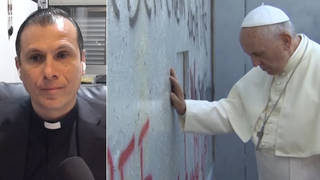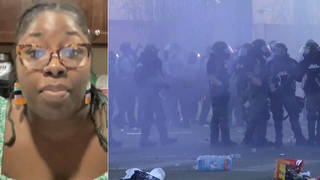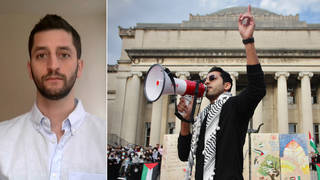
Guests
- Dan Gilleonattorney for the family of Alfred Olango, an unarmed African-American man who was shot and killed Tuesday in El Cajon, just outside of San Diego. Dan also represents Officer Christine Greer, the plaintiff in a sexual harassment lawsuit against Richard Gonsalves, one of the officers involved in the shooting.
- Christopher Rice-Wilsonassociate director at Alliance San Diego.
Protests continue in the San Diego, California, suburb of El Cajon, where police shot and killed an unarmed African-American man Tuesday after his sister called 911 to report her brother was having a mental health emergency. Eyewitnesses in El Cajon said 38-year-old Alfred Olango was holding his hands up when he was tased by one police officer and then fired upon five times by another officer. Olango was a 38-year-old father of two and a Ugandan refugee who moved to the San Diego area 20 years ago. On Wednesday, police confirmed Alfred Olango did not have a gun. The object he pointed at police was a three-inch-long silver e-cigarette. We speak to Olango family attorney Dan Gilleon and Christopher Rice-Wilson of Alliance San Diego.
Transcript
NERMEEN SHAIKH: Protests continue in the San Diego, California, suburb of El Cajon, where police shot and killed an unarmed African-American man Tuesday after his sister called 911 to report her brother was having a mental health emergency. Eyewitnesses in El Cajon said 38-year-old Alfred Olango was holding his hands up when he was tased by one police officer and then fired on five times by another officer. Olango was a 38-year-old father of two and a Ugandan refugee who moved to the San Diego area 20 years ago.
In a dramatic video posted to Facebook, a woman named Rumbie Mubaiwa begins filming moments after Olango is shot dead. In the background, Olango’s sister is heard crying over the death of her brother.
RUMBIE MUBAIWA: OK, so the police did it again, y’all. They shot another unarmed black person, as usual. And the lady is saying she called them for help, not to kill her brother. And they shot her brother.
AMY GOODMAN: In the video, Alfred Olango’s grieving sister is seen tearfully confronting police. She tells them, “I called you to help me, but you killed my brother.”
OLANGO’S SISTER: Guys, why couldn’t you tase him? Why couldn’t you guys tase him? Why? Why? Why? Why? Why?
RUMBIE MUBAIWA: What’s his birthday, so they could find his information?
OLANGO’S SISTER: Why couldn’t you guys tase him? I told you he’s sick. And you guys shot him.
AMY GOODMAN: The sister of Alfred Olango can be heard in the video saying, quote, “I called three times for them to come help me. Nobody came. They said it’s not priority,” end-quote. Police scanner audio at the time of the shooting reveals officers knew they were responding to a so-called 5150 call, or a mental health emergency. It does not appear that officers dispatched a Psychiatric Emergency Response Team. El Cajon Police Chief Jeff Davis acknowledged it took officers 50 minutes—that’s 5-0 minutes—to respond to the 911 call of Olango’s sister. He said there was no weapon found at the scene of the killing. Chief Davis disputed witness accounts that Olango had his hands in the air, saying the man pointed an object at an officer with both hands as if to fire a handgun.
POLICE CHIEF JEFF DAVIS: The male subject paced back and forth while the officers tried to talk to him. At one point, the male rapidly drew an object from his front pants pocket, placed both hands together on it and extended it rapidly towards the officer, taking what appeared to be a shooting stance, putting the object in the officer’s face. At this time, one of the officers with the Taser discharged his Taser in an effort to subdue the subject. Simultaneously, the officer who had the object pointed at him discharged his firearm, striking the male.
NERMEEN SHAIKH: On Wednesday, police confirmed Alfred Olango did not have a gun. The object he pointed at police was a three-inch-long silver e-cigarette. The shooting is just the most recent in a string of police shootings of primarily men of color with mental illness or disability. Just last week, police in Charlotte, North Carolina, shot and killed Keith Scott, a 43-year-old father of seven who reportedly had suffered a traumatic brain injury during a motorcycle accident in 2015. In July, a police officer in North Miami contends he mistakenly shot an African-American behavioral therapist, Charles Kinsey, when he was aiming for Arnaldo Rios Soto, a 26-year-old autistic man.
AMY GOODMAN: Who was simply cradling a toy truck.
In addition to concerns over the El Cajon Police Department’s response to what was a mental health crisis, questions are being raised about El Cajon police officer Richard Gonsalves, who’s been identified as the shooter, the officer who fatally shot Olango. Last year, Gonsalves was sued for sexual harassment after making lewd propositions and texting explicit photos, naked photos of his private parts, to his subordinate officer. He was demoted to officer from sergeant. Gonsalves was just served with a second suit in August of this year, after the harassment continued.
Well, for more, we’re joined by two guests. Dan Gilleon is the attorney for the family of Alfred Olango and also represents Officer Christine Greer, the plaintiff in the sexual harassment lawsuit against Gonsalves. Christopher Rice-Wilson is also with us, associate director at Alliance San Diego.
We welcome you both to Democracy Now! Dan Gilleon, let’s begin with you. Explain what took place—you are the lawyer for Alfred Olango’s family—how this happened, when the sister called and said her brother was having a mental health emergency. Explain what took place next.
DAN GILLEON: Well, you know, there’s a lot of facts that we just don’t know right now. And that’s one of the problems that I have with the way that the city of El Cajon and the police department is handling this. There is a video available. They took a still image from that video yesterday and put it out there in the media and began litigating this case in the media, but selecting the still image that helps them the most. So I don’t have a lot of the facts right now, and I don’t feel comfortable saying exactly what happened, because we just don’t know.
I can tell you this: When the police officers arrived on the scene, they knew that they were arriving in a situation that called for a PERT, a Psychiatric Emergency Response Team. They knew that. And they are trained on how to deal with people with mental illness. And one of the things that they know is that people with mental illnesses will act like people with mental illnesses. And the sister was clear with them that he was having a mental breakdown. He was having a mental breakdown. He had just lost someone very close to him. I do not know the effect of that recent loss on any other underlying situation or conditions of his, but they did know it. Even the chief police acknowledged that he was acting erratically and running in and out of traffic. So they knew that.
Instead of calling the PERT team, which was the team that’s designed to handle these situations and de-escalate these situations, they sent out this Richard Gonsalves, who, in my opinion, based upon the way he has behaved in the past, is a cowboy. He’s a cowboy that went out there and took matters into his own hands and, I believe, escalated the situation to the point where this mentally ill person acted like a mentally ill person and raised his hands towards him.
We don’t know if the officer with the laser deployed that—of Taser deployed that Taser first. We just don’t know that, because we don’t have the video. That would be an important thing to know. There was a comment by the chief of police that the firing officer—this would be Richard Gonsalves—that he fired simultaneously. Well, what we talk about in the business when we do police shooting cases is talk about sympathetic fire. And the police departments are taught how not to have situations like this result in a death as a result of sympathetic fire. And what happens is, oftentimes, when a Taser goes off, it creates a loud noise, and other officers who have their weapons drawn will fire, and not because any other reason other than they’ve just now heard another shot. We don’t know whether or not the officer who was firing the Taser followed protocol, which was to announce loudly “Taser, Taser, Taser” and then fire. We don’t know if he did that or not, because they won’t release that video. That process of announcing a Taser is very important, because it helps prevent the sympathetic fire.
Again, my role right now is to defend the case that’s being litigated in the media by the El Cajon Police Department. It’s a completely unfair thing to do, that less than 24 hours after this man dies, that the police department is cherry-picking one still image, releasing it to the media, all for the purpose of building their own case, which it boils down to: It was all his own fault. He had it coming. He shouldn’t have raised his hands. If he hadn’t raised his hands, he would be alive. I don’t believe the facts bear that scenario out all that well, but we just don’t know yet.
AMY GOODMAN: We’re going to go to break, then come back to this discussion. Dan Gilleon is the attorney for Alfred Olango’s family. Alfred Olango was a Ugandan refugee in El Cajon. Christopher Rice-Wilson, an activist, will talk about the protests that are taking place and what are the demands. And we’ll be speaking with John Snook, who is with Treatment Advocacy Center, about mentally ill people and how the police should deal with them. Stay with us.
[break]
AMY GOODMAN: “Gunshots” by Bambu, featuring Kiwi, here on Democracy Now!, democracynow.org, The War and Peace Report. I’m Amy Goodman, with Nermeen Shaikh.
NERMEEN SHAIKH: Protests continue in the San Diego, California, suburb of El Cajon, where police shot and killed an unarmed African-American man Tuesday after his sister called 911 to report her brother was having a mental health emergency. After Tuesday’s shooting, Alfred Olango’s sister explained the encounter with the police.
OLANGO’S SISTER: I called the 911 three times to come and help my brother, that he’s mentally perturbed and he needed help. And I thought they would send somebody to help him and get some crisis communication going on. The police officer, of course, came. He was running around, crossing the street. He almost got hit by the car. So I kind of tailgated him with my car and tried to get some help so they can take him to the hospital. When the police officer came, I told him, and they finally got him, tried to tell my brother, “Please, put your hands up. Don’t put your hands in your pocket. Listen.” And I told the police, “Please don’t shoot him. He’s sick.” I did not call the police officer to come and kill my brother.
NERMEEN SHAIKH: That was Alfred Olango’s sister talking about what happened when her brother was shot. We’re continuing our conversation now with Dan Gilleon, the attorney for Olango’s family, and Christopher Rice-Wilson. So, I’d like to ask Christopher Rice-Wilson about—could you say something about your response to the shooting?
CHRISTOPHER RICE-WILSON: Well, I’m—you know, I’m simply aghast at the actions taken that day by the El Cajon Police Department and continuing with the police chief’s press conference that, you know, revealed a still photo that made their case and presented Olango as a threat. The community is really upset right now, and we want justice for Alfred Olango. We want a transparent investigation. We don’t believe that we can get that here in San Diego, and we’re asking Attorney General Loretta Lynch to assign an investigator from the Department of Justice. The community is really upset right now. We are standing with the family, demanding justice, and hoping and praying that someone will come help us here in San Diego.
AMY GOODMAN: Can you talk about the history of police relations in San Diego?
CHRISTOPHER RICE-WILSON: Well, I mean, I think police relations with communities of color across this country are not very good right now. We see this happening across the country, so we don’t have to isolate it to San Diego. But when you talk about the El Cajon Police Department and its history with the community, there was a grand jury report about a year ago that recommended improvements in the El Cajon Police Department’s handling of the homeless and mentally ill, which have largely gone ignored. There is not a significant black population in El Cajon, and the black folks who do live in El Cajon often feel picked on by the police department, harassed by the police department. And so, when we see what happened the other day to Mr. Olango, it did not come as a surprise to many people, who said it was just a matter of time, prior to this event.













Media Options